Hiring the right Svelte Framework developer can be challenging. Asking targeted questions during interviews helps identify candidates with the necessary skills and experiences needed for your team.
This blog post will cover essential Svelte Framework interview questions for various levels including basic, junior, mid-tier, and topics like components, lifecycle management, and state management. Each section is crafted to offer interviewers specific questions and answers to assess a candidate's proficiency and potential.
By using these questions, you can streamline your process and ensure you hire a qualified Svelte developer. To further enhance your recruitment, consider using our Svelte online test for an initial skills assessment.
Table of contents
10 basic Svelte Framework interview questions and answers to assess candidates
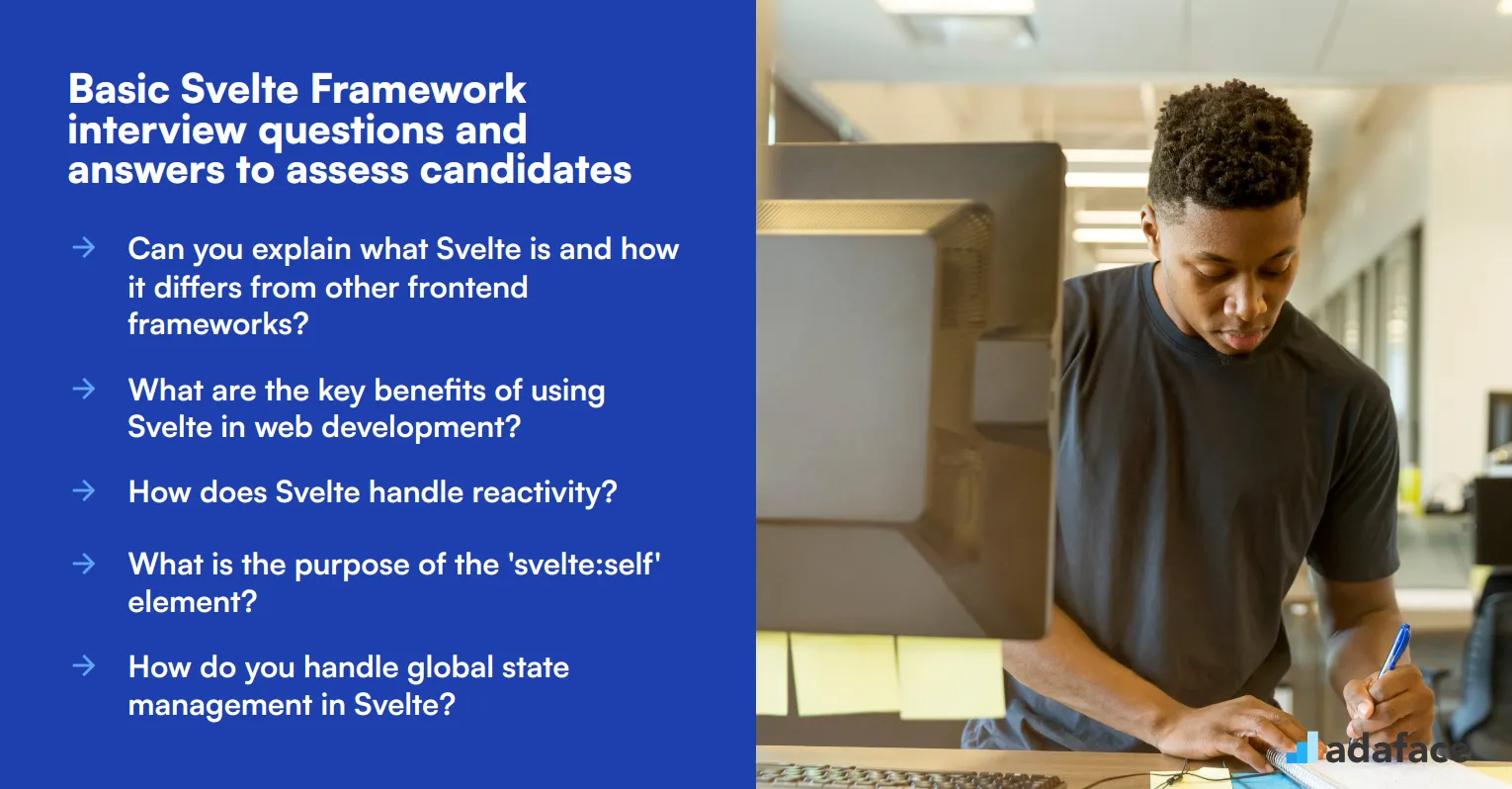
Ready to dive into the world of Svelte? These 10 basic interview questions will help you assess candidates' understanding of this nifty framework. Use them to gauge a candidate's familiarity with Svelte's core concepts and their ability to apply them in real-world scenarios. Remember, the goal is to spark a conversation, not to stump your interviewees!
1. Can you explain what Svelte is and how it differs from other frontend frameworks?
Svelte is a modern JavaScript framework for building user interfaces. Unlike traditional frameworks like React or Vue, Svelte shifts much of the work to compile-time rather than run-time. This means that Svelte converts your code into efficient JavaScript at build time, resulting in smaller bundle sizes and faster performance.
A strong candidate should highlight that Svelte doesn't use a virtual DOM, instead updating the DOM directly when the state changes. They might also mention Svelte's reactive declarations and how they simplify state management.
2. What are the key benefits of using Svelte in web development?
Candidates should be able to articulate several advantages of using Svelte:
- Smaller bundle sizes, leading to faster load times
- Improved runtime performance due to compile-time optimizations
- Simpler, more intuitive syntax compared to other frameworks
- Built-in state management without additional libraries
- Less boilerplate code, resulting in increased developer productivity
Look for candidates who can explain these benefits in the context of real-world applications. They should understand how these advantages translate to better user experiences and more efficient development processes.
3. How does Svelte handle reactivity?
Svelte's reactivity system is one of its standout features. Candidates should explain that Svelte uses a compile-time approach to reactivity. When you assign to a variable that's used in the template, Svelte automatically generates code to update the DOM.
A thorough answer might include:
- The use of the '$:' syntax for reactive declarations
- How Svelte tracks dependencies and updates only what's necessary
- The difference between reactive statements and reactive values
Look for candidates who can provide examples of how they've used Svelte's reactivity in their projects, demonstrating a practical understanding of this core concept.
4. What is the purpose of the 'svelte:self' element?
The 'svelte:self' element is used for recursive components in Svelte. It allows a component to include itself, which is useful for creating tree-like structures or nested comments.
A strong candidate should be able to explain:
- When and why you would use 'svelte:self'
- How it differs from directly using the component's name
- Potential pitfalls, such as infinite loops, and how to avoid them
Look for candidates who can provide real-world examples of where they've used or encountered the need for recursive components, showing practical application of this advanced Svelte feature.
5. How do you handle global state management in Svelte?
Svelte provides several ways to manage global state. A comprehensive answer should cover:
- Using stores (writable, readable, and derived stores)
- The Context API for sharing data between components
- How to create custom stores for complex state management
- When to use each approach and their trade-offs
Strong candidates might also discuss how Svelte's approach compares to state management in other frameworks, such as Redux in React. They should be able to explain scenarios where Svelte's built-in state management is sufficient and when more complex solutions might be necessary.
6. Explain the concept of transitions in Svelte and give an example of when you might use them.
Transitions in Svelte are a way to animate elements as they enter and leave the DOM. Candidates should explain that Svelte provides built-in transition functions like fade, fly, slide, and scale, which can be easily applied to elements.
A good answer might include:
- How to use the 'transition:' directive
- The difference between in and out transitions
- How to create custom transition functions
- Performance considerations when using transitions
Look for candidates who can provide specific examples of where transitions improve user experience, such as in modals, tooltips, or list items. They should demonstrate an understanding of when to use transitions judiciously to enhance rather than detract from the user interface.
7. What are Svelte actions and how do they differ from event handlers?
Svelte actions are a way to add custom behavior to DOM elements. Unlike event handlers, which respond to specific events, actions can set up and tear down any kind of behavior.
Candidates should explain:
- How to define and use an action
- The lifecycle of an action (initialization and destruction)
- Use cases for actions, such as integrating third-party libraries or setting up complex event listeners
- How actions can return an object with update and destroy methods
Look for answers that demonstrate an understanding of when to use actions versus simple event handlers or component logic. Strong candidates might provide examples of custom actions they've created in past projects.
8. How does Svelte handle server-side rendering (SSR)?
Server-side rendering in Svelte is primarily handled through SvelteKit, the official application framework for Svelte. A good answer should cover:
- The benefits of SSR, such as improved initial load times and SEO
- How SvelteKit facilitates both SSR and client-side navigation
- The concept of hydration in Svelte applications
- Challenges in implementing SSR, such as managing state and handling browser-only APIs
Strong candidates should be able to discuss the trade-offs between SSR and client-side rendering, and scenarios where each approach is more appropriate. They might also mention alternatives to SvelteKit for SSR in Svelte applications.
9. What are slots in Svelte and how do they enhance component composition?
Slots in Svelte are a mechanism for passing content into components, similar to the children prop in React. Candidates should explain:
- How to define and use default slots
- The concept of named slots for more specific content placement
- How slots enable more flexible and reusable component designs
- The use of slot props to pass data back to the parent
Look for answers that demonstrate an understanding of component composition and how slots contribute to creating more versatile, reusable components. Strong candidates might provide examples of how they've used slots to create flexible layout components or complex UI elements.
10. How does Svelte handle component lifecycle?
Svelte provides several lifecycle functions that allow developers to hook into different stages of a component's existence. A comprehensive answer should cover:
- onMount: for running code when a component is first rendered to the DOM
- onDestroy: for cleanup when a component is removed from the DOM
- beforeUpdate and afterUpdate: for running code before and after the DOM is updated
- tick: for running code after the next DOM update
Candidates should explain how these lifecycle functions differ from those in other frameworks and provide examples of when each might be used. Look for answers that demonstrate an understanding of the component lifecycle and how to leverage these functions for tasks like data fetching, setting up subscriptions, or managing side effects.
20 Svelte Framework interview questions to ask junior developers
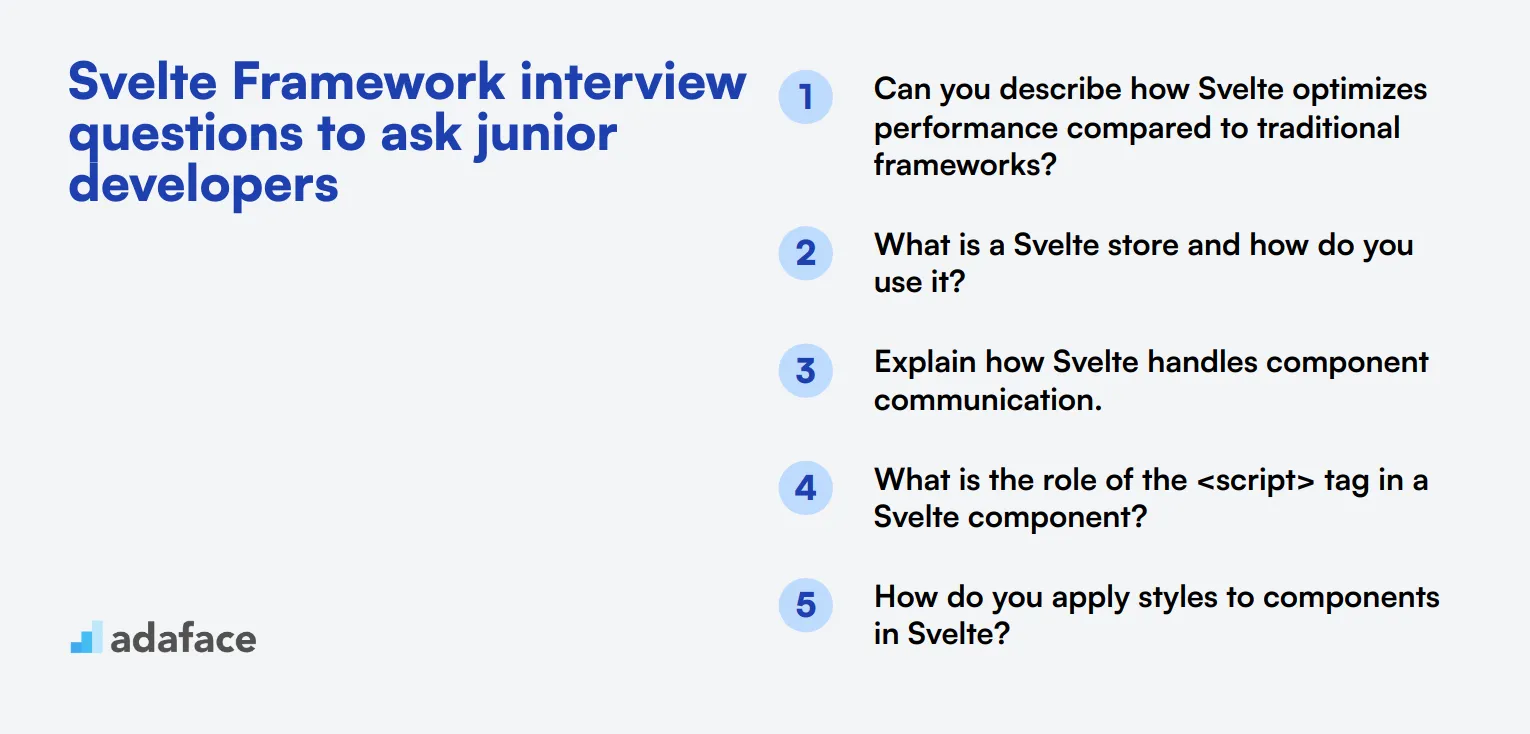
To ensure you select the best talent for your team, these carefully curated Svelte Framework interview questions will help evaluate the foundational skills of junior developers. Use this list during interviews to identify candidates with a solid understanding of frontend development and the potential to grow with your company.
- Can you describe how Svelte optimizes performance compared to traditional frameworks?
- What is a Svelte store and how do you use it?
- Explain how Svelte handles component communication.
- What is the role of the <script> tag in a Svelte component?
- How do you apply styles to components in Svelte?
- Can you give an example of how to use event forwarding in Svelte?
- How do you implement conditional rendering in Svelte?
- What are reactive declarations in Svelte and when would you use them?
- Explain the concept of reactive assignments in Svelte.
- How do you bind HTML attributes in Svelte?
- What is the significance of the key directive in Svelte?
- How do you create and use custom events in Svelte?
- Can you explain the use of bind:this in Svelte?
- How would you debug a Svelte application?
- What are Svelte stores and how do they differ from component state?
- How do you handle form inputs in Svelte?
- Explain the use of the await block in Svelte.
- How do you manage side-effects in Svelte components?
- Can you describe how Svelte’s compiler works?
- What are some common use cases for Svelte components?
10 intermediate Svelte Framework interview questions and answers to ask mid-tier developers.
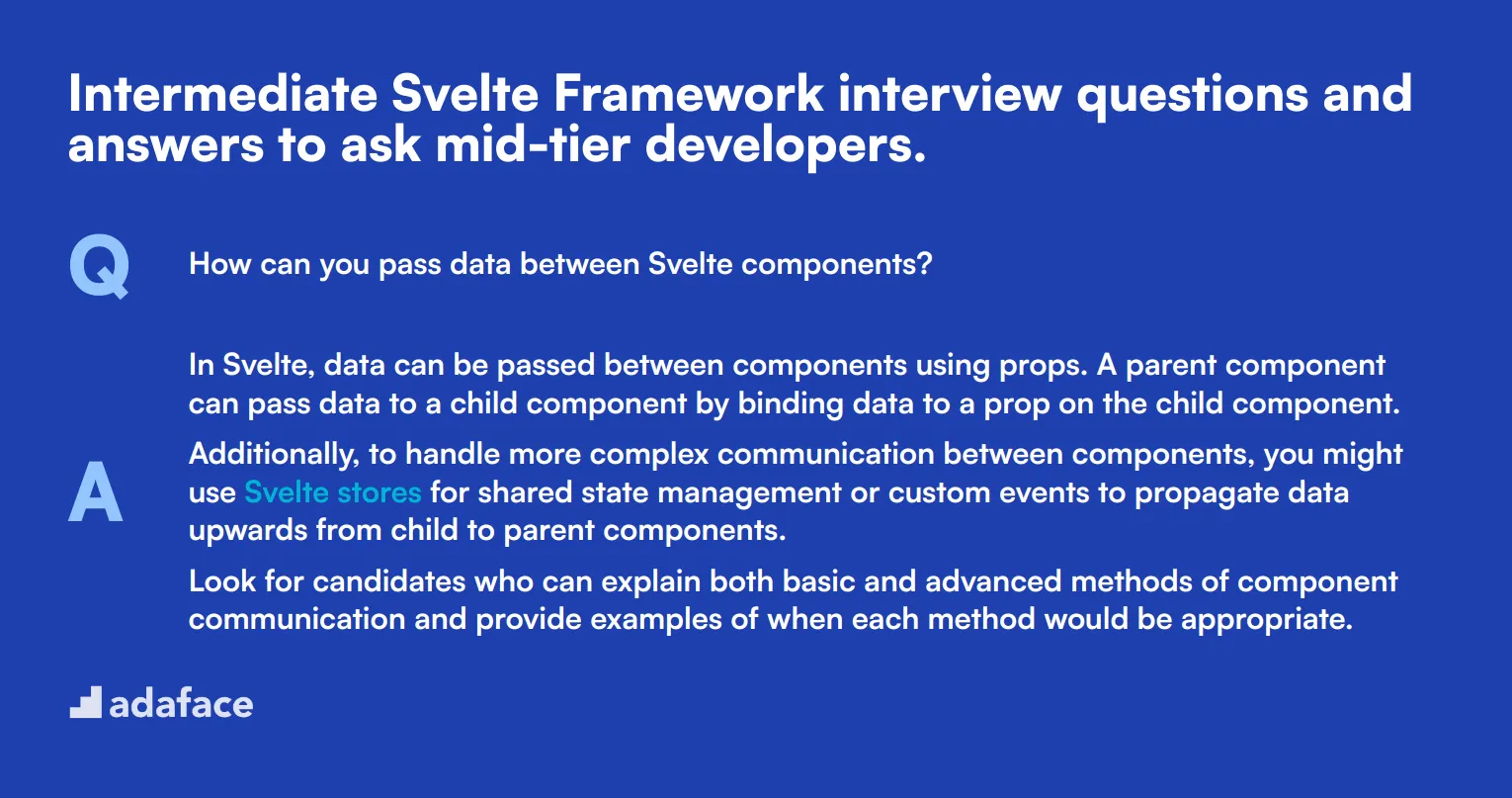
To evaluate whether mid-tier developers possess the required skills and understanding of the Svelte Framework, ask them some of these 10 intermediate Svelte interview questions. These questions are designed to gauge their practical knowledge and ability to apply Svelte concepts in real-world scenarios.
1. How can you pass data between Svelte components?
In Svelte, data can be passed between components using props. A parent component can pass data to a child component by binding data to a prop on the child component.
Additionally, to handle more complex communication between components, you might use Svelte stores for shared state management or custom events to propagate data upwards from child to parent components.
Look for candidates who can explain both basic and advanced methods of component communication and provide examples of when each method would be appropriate.
2. What are Svelte stores and how do they help manage state?
Svelte stores are a reactive state management solution provided by the Svelte framework. They allow you to create a shared state that can be accessed and manipulated by any component in the application.
There are three types of stores in Svelte: writable, readable, and derived stores. Writable stores can be read and updated, readable stores only allow reading, and derived stores are used to create new stores from existing ones.
An ideal candidate should explain the purpose of each type of store and give examples of use cases where each type would be beneficial.
3. How do you optimize Svelte applications for performance?
Svelte optimizes performance primarily through its compiler, which converts the application code into highly efficient JavaScript at build time, eliminating the need for a virtual DOM.
Developers can further optimize Svelte applications by using techniques like code splitting, lazy loading, and minimizing reactivity computations by carefully managing reactive statements and stores.
Candidates should demonstrate an understanding of both built-in optimizations and additional performance tuning techniques they have applied in real-world scenarios.
4. Can you explain how context works in Svelte?
Context in Svelte is used to pass data down the component tree without having to pass props manually at each level. This is particularly useful for globally shared data, such as themes or localization settings.
It involves the use of setContext in a parent component to provide context and getContext in a child component to consume it.
Look for candidates who can explain the practical benefits of context and provide examples of situations where context would be preferable to props or stores.
5. What is reactive programming in Svelte and how does it work?
Reactive programming in Svelte is achieved through reactive statements and declarations. Reactive statements automatically re-run whenever their dependencies change, which helps in updating the UI efficiently.
This is done using the $: syntax in Svelte, allowing developers to declare dependencies explicitly and ensuring that updates are only made when necessary.
Candidates should explain how this approach enhances performance and provide examples of how they have utilized reactive programming in their projects.
6. How are Svelte components styled, and what are the benefits of Svelte's approach to styling?
Svelte components are styled using scoped styles defined within the <style> tag directly in the component file. These styles are automatically scoped to the component to avoid conflicts.
Svelte also supports global styles and allows developers to use preprocessors like SCSS or PostCSS for more advanced styling needs.
An ideal candidate should mention the benefits of scoped styles in maintaining modular and conflict-free CSS, as well as their experience with integrating CSS preprocessors in Svelte projects.
7. How do you manage side-effects in Svelte components?
Side-effects in Svelte components are managed using the onMount, beforeUpdate, and afterUpdate lifecycle functions. These functions allow developers to perform actions at specific stages of a component's lifecycle.
For instance, onMount is used to run code after a component is first rendered, while beforeUpdate and afterUpdate handle actions before and after updates, respectively.
Candidates should explain how they use these lifecycle functions to manage side-effects effectively and provide examples of common side-effects they handle in their applications.
8. What strategies do you use for debugging Svelte applications?
Debugging Svelte applications can be done using standard JavaScript debugging techniques, such as using console.log statements and browser developer tools.
Additionally, Svelte provides specific debugging tools like the Svelte DevTools extension, which allows for inspection of component hierarchies and state.
Look for candidates who can detail their debugging process, including any Svelte-specific tools they use and how they approach diagnosing and resolving issues.
9. How do you implement animations in Svelte?
Svelte provides built-in support for animations using the transition and animate directives. The transition directive is used for entering and leaving animations, while animate handles animations for changes in layout.
Additionally, custom animations can be implemented using JavaScript or CSS keyframes for more complex requirements.
Candidates should be able to explain the different animation directives, provide examples of when they have used them, and discuss any custom animation solutions they have implemented.
10. Can you explain the concept of reactive assignments in Svelte?
Reactive assignments in Svelte allow variables to automatically update their value when their dependencies change. This is achieved using the $: syntax.
For example, if you have a variable that depends on the value of another variable, you can use a reactive assignment to ensure the dependent variable is always in sync.
Look for candidates who can provide practical examples of reactive assignments and discuss the benefits of using them for maintaining up-to-date state in their applications.
12 Svelte Framework interview questions about components and lifecycle management
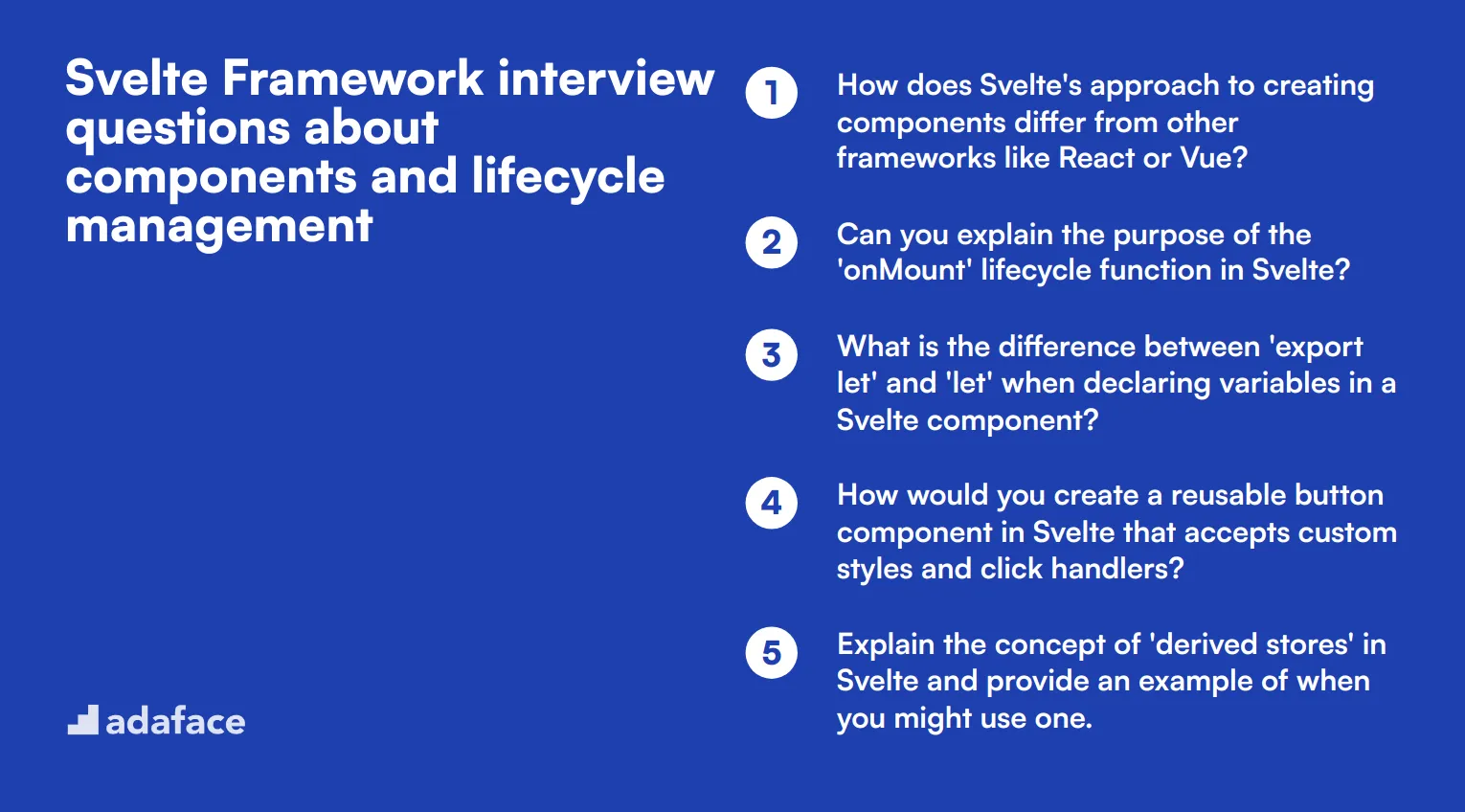
To assess a candidate's proficiency in Svelte's component architecture and lifecycle management, consider using these 12 interview questions. They are designed to help you evaluate a front-end developer's understanding of Svelte's unique approach to building user interfaces and managing component behavior.
- How does Svelte's approach to creating components differ from other frameworks like React or Vue?
- Can you explain the purpose of the 'onMount' lifecycle function in Svelte?
- What is the difference between 'export let' and 'let' when declaring variables in a Svelte component?
- How would you create a reusable button component in Svelte that accepts custom styles and click handlers?
- Explain the concept of 'derived stores' in Svelte and provide an example of when you might use one.
- How do you handle component cleanup in Svelte when a component is destroyed?
- What is the purpose of the '$:' syntax in Svelte, and how does it relate to reactivity?
- Can you describe a scenario where you would use a 'svelte:component' element?
- How do you implement two-way binding in Svelte forms?
- Explain the difference between 'on:click' and 'on:click|preventDefault' in Svelte event handling.
- What is the purpose of the 'use:' directive in Svelte, and how might you use it to create a custom action?
- How would you implement a component that renders different content based on screen size using Svelte?
8 Svelte Framework interview questions and answers related to state management
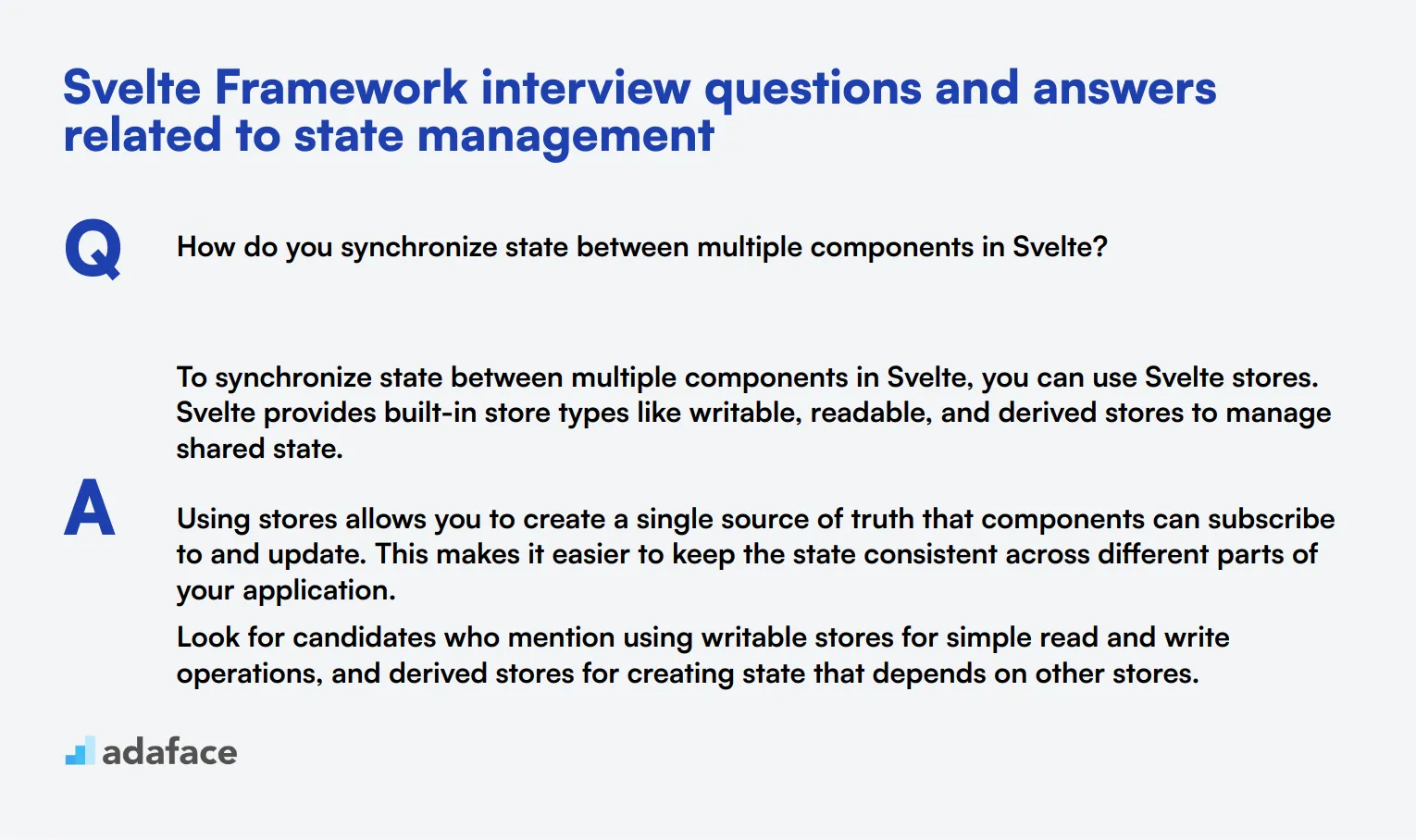
To determine if candidates have the right understanding of managing state in Svelte, use these insightful interview questions. These will help you evaluate their knowledge and approach to handling state in Svelte applications effectively.
1. How do you synchronize state between multiple components in Svelte?
To synchronize state between multiple components in Svelte, you can use Svelte stores. Svelte provides built-in store types like writable, readable, and derived stores to manage shared state.
Using stores allows you to create a single source of truth that components can subscribe to and update. This makes it easier to keep the state consistent across different parts of your application.
Look for candidates who mention using writable stores for simple read and write operations, and derived stores for creating state that depends on other stores.
2. Can you explain the difference between writable and derived stores in Svelte?
Writable stores in Svelte are used for storing values that can be read and updated. They are useful for maintaining simple, mutable state. Derived stores, on the other hand, are used to create new stores based on existing stores and are automatically updated when the source stores change.
Writable stores are created using the writable function, while derived stores are created using the derived function. Derived stores are ideal for states that depend on other states and need to be recalculated whenever the source state changes.
An ideal response should include examples of use cases for both writable and derived stores, indicating a clear understanding of when to use each.
3. How would you handle state management in a large Svelte application?
In a large Svelte application, state management can be handled by combining local component state with Svelte stores. Local state can be used for simple, isolated state management within individual components, while Svelte stores are useful for global state that needs to be shared across multiple components.
For more complex state management, you might consider using derived stores to manage dependent state and writable stores for shared, mutable state. Additionally, breaking down the application into smaller, reusable components can help manage state more effectively.
A good candidate should demonstrate an understanding of these techniques and provide examples of how they would implement them in a large application.
4. What are some potential pitfalls of using Svelte stores for state management?
One potential pitfall of using Svelte stores for state management is the risk of creating tightly coupled components. When multiple components directly subscribe to and modify the same store, it can lead to complex dependencies and make the application harder to maintain.
Another issue could be performance-related. If stores are not used correctly, it might result in unnecessary re-renders, affecting the application's performance.
Candidates should mention these pitfalls and suggest best practices, such as using derived stores to manage dependencies and ensuring components are loosely coupled.
5. How do you manage asynchronous state updates in Svelte?
Asynchronous state updates in Svelte can be managed using Svelte stores in combination with JavaScript's async/await syntax. For example, you can create a writable store and update its value asynchronously within an async function.
Another approach is using the Svelte's await block to handle promises directly within the component's template. This allows you to render different content based on the promise's state (pending, resolved, or rejected).
An ideal response should include a discussion of these techniques and how they help manage asynchronous operations effectively in Svelte applications.
6. How do you handle form state in Svelte?
Form state in Svelte can be managed using component state and Svelte stores. For simple forms, local component state using Svelte's reactive variables may suffice.
For more complex forms, you might use writable stores to manage the form state globally. This allows different parts of the application to access and update the form state as needed.
Candidates should explain how they would bind form input fields to state variables and use event handlers to update the state. They should also discuss the benefits of using Svelte stores for managing form state in larger applications.
7. Can you discuss the pros and cons of using Svelte's built-in state management versus external libraries?
Svelte's built-in state management is simple and intuitive, making it easy to manage state for small to medium-sized applications. It eliminates the need for additional dependencies and integrates seamlessly with Svelte's reactivity model.
However, for very large applications with complex state management requirements, external libraries like Redux or MobX might offer more advanced features and better scalability. These libraries provide robust solutions for handling immutable state, time-travel debugging, and middleware integration.
An ideal candidate should weigh these pros and cons and suggest scenarios where using external libraries would be beneficial.
8. How do you debug state changes in Svelte applications?
Debugging state changes in Svelte applications can be done using browser developer tools and Svelte's built-in debugging features. You can log state changes to the console using console.log statements to track how state is updated.
Svelte also provides a dev mode that shows helpful warnings and errors. Moreover, using Svelte's reactive declarations with the $: syntax can help you understand how state changes propagate through your application.
Candidates should discuss these techniques and might mention tools like the Svelte DevTools extension for an enhanced debugging experience.
Which Svelte Framework skills should you evaluate during the interview phase?
Assessing a candidate's skills in a single interview is a challenging task, as it often involves a wide range of competencies. However, when it comes to the Svelte Framework, there are specific core skills that can significantly impact a candidate's ability to contribute effectively to your team.
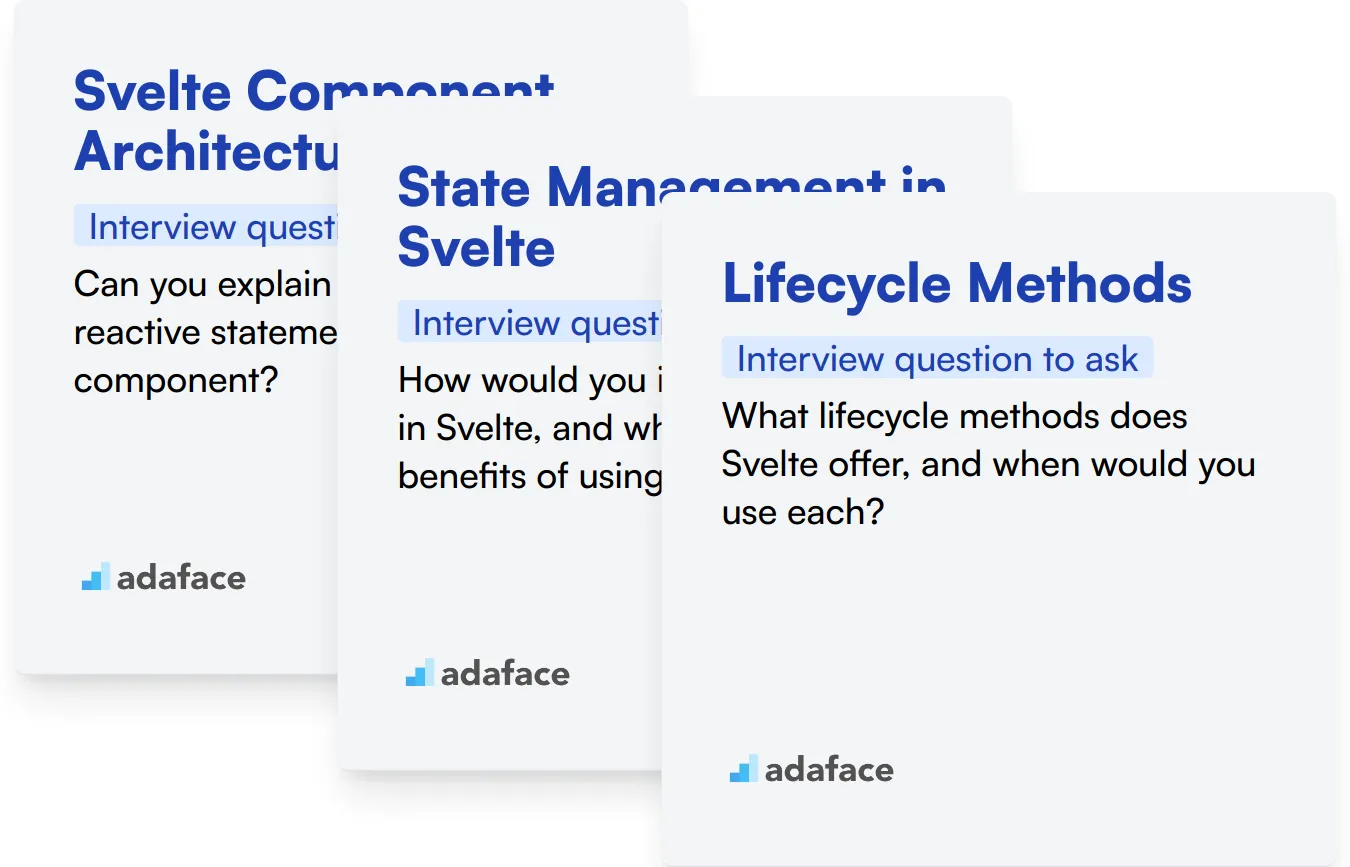
Svelte Component Architecture
You can evaluate this skill through an assessment test that includes relevant MCQs focused on Svelte's component concepts. For example, our Svelte online test provides a range of questions that can help filter candidates based on their knowledge in this area.
Additionally, consider asking targeted interview questions to further gauge the candidate's expertise in Svelte component architecture.
Can you explain how Svelte's reactive statements work within a component?
Look for candidates who can articulate the purpose of reactive statements and provide examples of their use. Strong responses will demonstrate an understanding of how Svelte tracks variable changes and updates the DOM accordingly.
State Management in Svelte
To assess this skill, consider using a tailored MCQ test that covers state management principles in Svelte, such as stores and props. Our Svelte online test includes relevant questions for this purpose.
You may also want to ask the candidate about their approach to managing state within Svelte applications.
How would you implement a store in Svelte, and what are the benefits of using it?
Candidates should discuss the concept of stores, how they help in sharing state across components, and the specific advantages they offer over traditional state management methods.
Lifecycle Methods
You can filter for this knowledge through a set of MCQs focused on Svelte's lifecycle methods. Our Svelte online test offers questions that directly touch on these concepts.
Additionally, you could ask the candidate to explain their experience with lifecycle methods in Svelte applications.
What lifecycle methods does Svelte offer, and when would you use each?
Look for candidates who can detail the different lifecycle methods like onMount, beforeUpdate, and onDestroy, including scenarios where each would be appropriately applied.
3 tips for using Svelte Framework interview questions
Before you start putting what you’ve learned to use, here are three tips to help you maximize the effectiveness of your Svelte Framework interview questions.
1. Start with skills tests to filter candidates
Using skill tests before interviews helps streamline the hiring process by filtering out unqualified candidates early.
For assessing Svelte Framework skills, consider using the Svelte Online Test from Adaface. This test assesses a candidate's knowledge and proficiency in working with the Svelte Framework.
Implementing these tests saves time and ensures that only the most qualified candidates make it to the interview stage.
2. Compile and focus your interview questions
Given the limited time during interviews, it's essential to select the most relevant questions to evaluate candidates effectively.
Consider incorporating questions from related areas such as JavaScript or HTML5 to assess a candidate’s overall front-end development skills.
This approach ensures you cover important aspects and get a comprehensive understanding of the candidate’s capabilities.
3. Ask follow-up questions
Relying solely on predefined questions might not reveal the true depth of a candidate’s knowledge.
Follow-up questions help verify the candidate’s understanding and uncover any gaps in their knowledge.
For example, if you ask about Svelte's reactive statements, a good follow-up question would be: 'Can you provide an example of a complex scenario where using reactive statements significantly improved performance?' This helps gauge their practical experience and problem-solving skills.
Assess Svelte skills accurately with online tests and interviews
If you're looking to hire someone with Svelte skills, it's important to assess their abilities accurately. The most effective way to do this is by using skill tests. Consider using our Svelte online test to evaluate candidates' proficiency in Svelte development.
After using the test to shortlist the best applicants, you can invite them for interviews. To streamline your hiring process and find top Svelte talent, check out our online assessment platform. It offers a range of tools to help you make informed hiring decisions.
Svelte Test
Download Svelte Framework interview questions template in multiple formats
Svelte Framework Interview Questions FAQs
The questions cover basic, junior, intermediate, and mid-tier skill levels, as well as specific topics like components and state management.
Use them to assess candidates' Svelte knowledge, tailor questions to the job level, and combine with practical tests for a thorough evaluation.
Yes, the post includes 3 tips for using Svelte Framework interview questions effectively.
The post suggests using online tests in combination with interviews for a more accurate assessment of Svelte skills.

40 min skill tests.
No trick questions.
Accurate shortlisting.
We make it easy for you to find the best candidates in your pipeline with a 40 min skills test.
Try for freeRelated posts
Free resources




